Accounting for Business BAP 12A Assignment 1, Trimester 1, 2020
VerifiedAdded on 2022/08/08
|11
|2600
|494
Homework Assignment
AI Summary
This document contains a detailed solution to an Accounting for Business assignment (BAP 12A) for Trimester 1, 2020. The assignment is divided into two parts. Part (a) requires the preparation of journal entries, posting them to general ledger accounts, and creating a trial balance for Orange Pty Ltd based on provided transactions. Part (b) provides the general ledger accounts with the balances. Part (c) requires the creation of a trial balance. Question 2 comprises of multiple-choice questions defining accounting, the accounting process, the conceptual framework, retained earnings, accounts, debits and credits, the recording process, journals, general ledgers, posting, trial balances, the accounting information system, and the elements of financial statements. The solution provides comprehensive answers to all questions and sub-parts, offering a complete guide for students studying accounting.
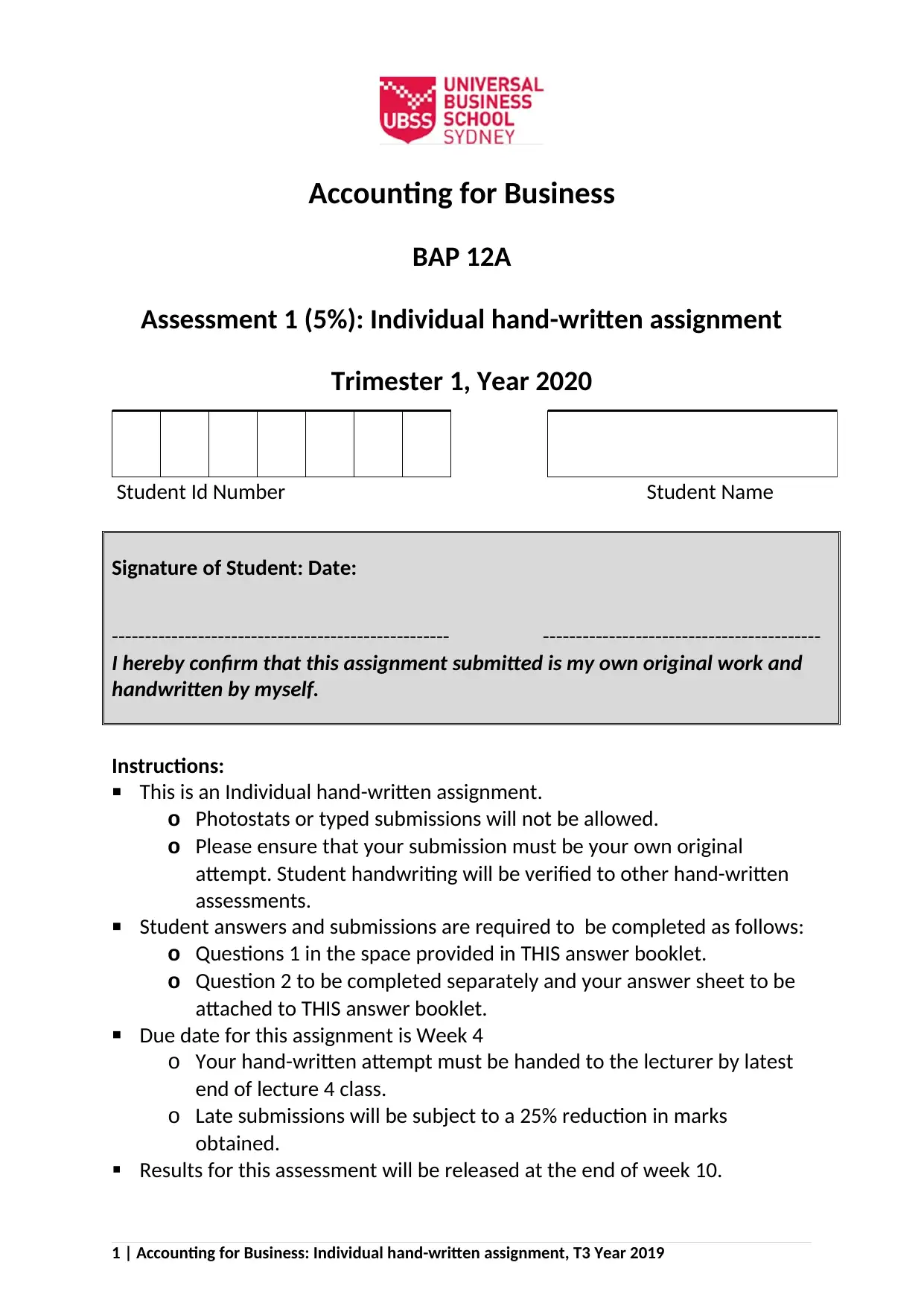
Accounting for Business
BAP 12A
Assessment 1 (5%): Individual hand-written assignment
Trimester 1, Year 2020
Student Id Number Student Name
Signature of Student: Date:
--------------------------------------------------- ------------------------------------------
I hereby confirm that this assignment submitted is my own original work and
handwritten by myself.
Instructions:
This is an Individual hand-written assignment.
o Photostats or typed submissions will not be allowed.
o Please ensure that your submission must be your own original
attempt. Student handwriting will be verified to other hand-written
assessments.
Student answers and submissions are required to be completed as follows:
o Questions 1 in the space provided in THIS answer booklet.
o Question 2 to be completed separately and your answer sheet to be
attached to THIS answer booklet.
Due date for this assignment is Week 4
o Your hand-written attempt must be handed to the lecturer by latest
end of lecture 4 class.
o Late submissions will be subject to a 25% reduction in marks
obtained.
Results for this assessment will be released at the end of week 10.
1 | Accounting for Business: Individual hand-written assignment, T3 Year 2019
BAP 12A
Assessment 1 (5%): Individual hand-written assignment
Trimester 1, Year 2020
Student Id Number Student Name
Signature of Student: Date:
--------------------------------------------------- ------------------------------------------
I hereby confirm that this assignment submitted is my own original work and
handwritten by myself.
Instructions:
This is an Individual hand-written assignment.
o Photostats or typed submissions will not be allowed.
o Please ensure that your submission must be your own original
attempt. Student handwriting will be verified to other hand-written
assessments.
Student answers and submissions are required to be completed as follows:
o Questions 1 in the space provided in THIS answer booklet.
o Question 2 to be completed separately and your answer sheet to be
attached to THIS answer booklet.
Due date for this assignment is Week 4
o Your hand-written attempt must be handed to the lecturer by latest
end of lecture 4 class.
o Late submissions will be subject to a 25% reduction in marks
obtained.
Results for this assessment will be released at the end of week 10.
1 | Accounting for Business: Individual hand-written assignment, T3 Year 2019
Paraphrase This Document
Need a fresh take? Get an instant paraphrase of this document with our AI Paraphraser
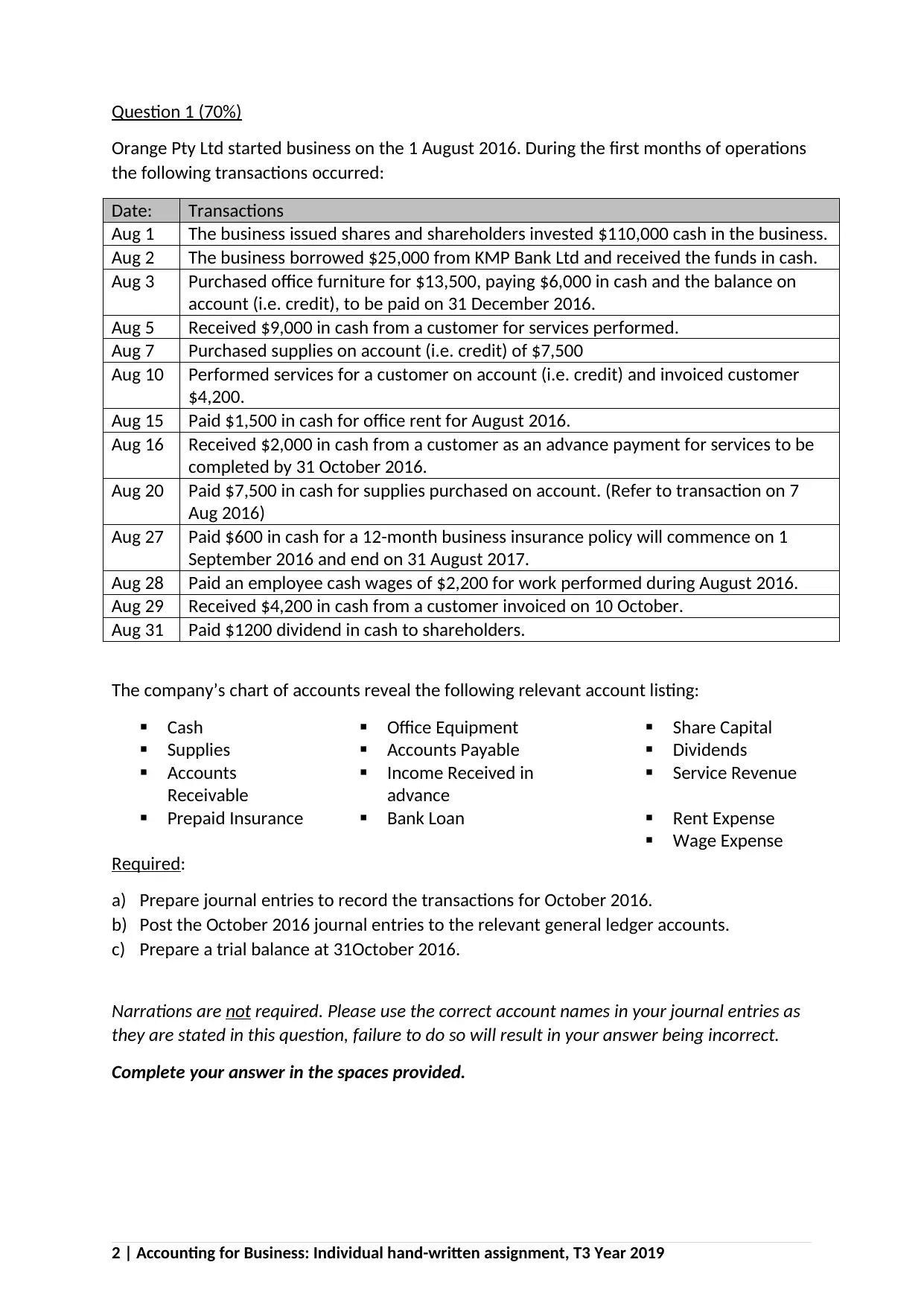
Question 1 (70%)
Orange Pty Ltd started business on the 1 August 2016. During the first months of operations
the following transactions occurred:
Date: Transactions
Aug 1 The business issued shares and shareholders invested $110,000 cash in the business.
Aug 2 The business borrowed $25,000 from KMP Bank Ltd and received the funds in cash.
Aug 3 Purchased office furniture for $13,500, paying $6,000 in cash and the balance on
account (i.e. credit), to be paid on 31 December 2016.
Aug 5 Received $9,000 in cash from a customer for services performed.
Aug 7 Purchased supplies on account (i.e. credit) of $7,500
Aug 10 Performed services for a customer on account (i.e. credit) and invoiced customer
$4,200.
Aug 15 Paid $1,500 in cash for office rent for August 2016.
Aug 16 Received $2,000 in cash from a customer as an advance payment for services to be
completed by 31 October 2016.
Aug 20 Paid $7,500 in cash for supplies purchased on account. (Refer to transaction on 7
Aug 2016)
Aug 27 Paid $600 in cash for a 12-month business insurance policy will commence on 1
September 2016 and end on 31 August 2017.
Aug 28 Paid an employee cash wages of $2,200 for work performed during August 2016.
Aug 29 Received $4,200 in cash from a customer invoiced on 10 October.
Aug 31 Paid $1200 dividend in cash to shareholders.
The company’s chart of accounts reveal the following relevant account listing:
Cash Office Equipment Share Capital
Supplies Accounts Payable Dividends
Accounts
Receivable
Income Received in
advance
Service Revenue
Prepaid Insurance Bank Loan Rent Expense
Wage Expense
Required:
a) Prepare journal entries to record the transactions for October 2016.
b) Post the October 2016 journal entries to the relevant general ledger accounts.
c) Prepare a trial balance at 31October 2016.
Narrations are not required. Please use the correct account names in your journal entries as
they are stated in this question, failure to do so will result in your answer being incorrect.
Complete your answer in the spaces provided.
2 | Accounting for Business: Individual hand-written assignment, T3 Year 2019
Orange Pty Ltd started business on the 1 August 2016. During the first months of operations
the following transactions occurred:
Date: Transactions
Aug 1 The business issued shares and shareholders invested $110,000 cash in the business.
Aug 2 The business borrowed $25,000 from KMP Bank Ltd and received the funds in cash.
Aug 3 Purchased office furniture for $13,500, paying $6,000 in cash and the balance on
account (i.e. credit), to be paid on 31 December 2016.
Aug 5 Received $9,000 in cash from a customer for services performed.
Aug 7 Purchased supplies on account (i.e. credit) of $7,500
Aug 10 Performed services for a customer on account (i.e. credit) and invoiced customer
$4,200.
Aug 15 Paid $1,500 in cash for office rent for August 2016.
Aug 16 Received $2,000 in cash from a customer as an advance payment for services to be
completed by 31 October 2016.
Aug 20 Paid $7,500 in cash for supplies purchased on account. (Refer to transaction on 7
Aug 2016)
Aug 27 Paid $600 in cash for a 12-month business insurance policy will commence on 1
September 2016 and end on 31 August 2017.
Aug 28 Paid an employee cash wages of $2,200 for work performed during August 2016.
Aug 29 Received $4,200 in cash from a customer invoiced on 10 October.
Aug 31 Paid $1200 dividend in cash to shareholders.
The company’s chart of accounts reveal the following relevant account listing:
Cash Office Equipment Share Capital
Supplies Accounts Payable Dividends
Accounts
Receivable
Income Received in
advance
Service Revenue
Prepaid Insurance Bank Loan Rent Expense
Wage Expense
Required:
a) Prepare journal entries to record the transactions for October 2016.
b) Post the October 2016 journal entries to the relevant general ledger accounts.
c) Prepare a trial balance at 31October 2016.
Narrations are not required. Please use the correct account names in your journal entries as
they are stated in this question, failure to do so will result in your answer being incorrect.
Complete your answer in the spaces provided.
2 | Accounting for Business: Individual hand-written assignment, T3 Year 2019
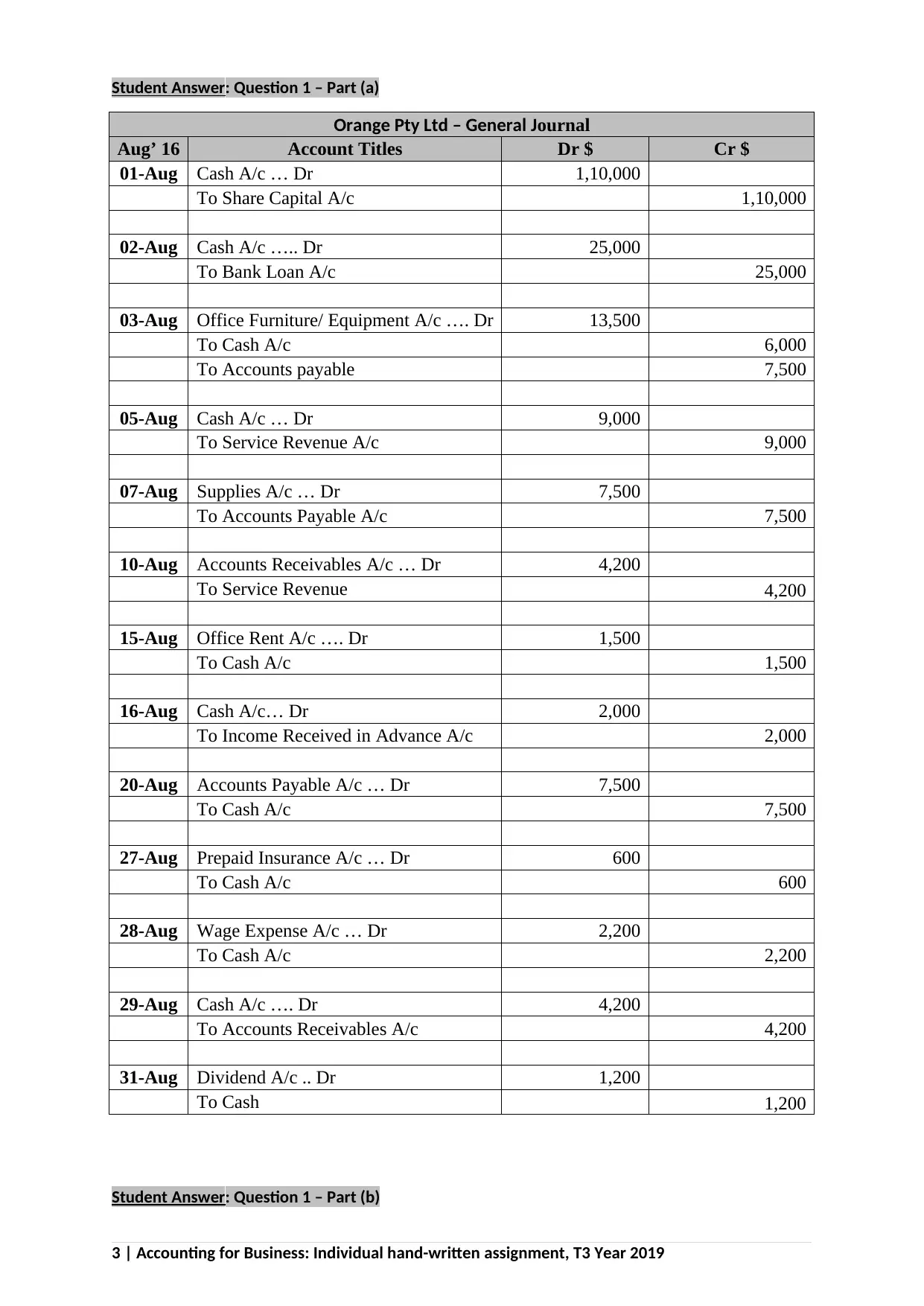
Student Answer: Question 1 – Part (a)
Orange Pty Ltd – General Journal
Aug’ 16 Account Titles Dr $ Cr $
01-Aug Cash A/c … Dr 1,10,000
To Share Capital A/c 1,10,000
02-Aug Cash A/c ….. Dr 25,000
To Bank Loan A/c 25,000
03-Aug Office Furniture/ Equipment A/c …. Dr 13,500
To Cash A/c 6,000
To Accounts payable 7,500
05-Aug Cash A/c … Dr 9,000
To Service Revenue A/c 9,000
07-Aug Supplies A/c … Dr 7,500
To Accounts Payable A/c 7,500
10-Aug Accounts Receivables A/c … Dr 4,200
To Service Revenue 4,200
15-Aug Office Rent A/c …. Dr 1,500
To Cash A/c 1,500
16-Aug Cash A/c… Dr 2,000
To Income Received in Advance A/c 2,000
20-Aug Accounts Payable A/c … Dr 7,500
To Cash A/c 7,500
27-Aug Prepaid Insurance A/c … Dr 600
To Cash A/c 600
28-Aug Wage Expense A/c … Dr 2,200
To Cash A/c 2,200
29-Aug Cash A/c …. Dr 4,200
To Accounts Receivables A/c 4,200
31-Aug Dividend A/c .. Dr 1,200
To Cash 1,200
Student Answer: Question 1 – Part (b)
3 | Accounting for Business: Individual hand-written assignment, T3 Year 2019
Orange Pty Ltd – General Journal
Aug’ 16 Account Titles Dr $ Cr $
01-Aug Cash A/c … Dr 1,10,000
To Share Capital A/c 1,10,000
02-Aug Cash A/c ….. Dr 25,000
To Bank Loan A/c 25,000
03-Aug Office Furniture/ Equipment A/c …. Dr 13,500
To Cash A/c 6,000
To Accounts payable 7,500
05-Aug Cash A/c … Dr 9,000
To Service Revenue A/c 9,000
07-Aug Supplies A/c … Dr 7,500
To Accounts Payable A/c 7,500
10-Aug Accounts Receivables A/c … Dr 4,200
To Service Revenue 4,200
15-Aug Office Rent A/c …. Dr 1,500
To Cash A/c 1,500
16-Aug Cash A/c… Dr 2,000
To Income Received in Advance A/c 2,000
20-Aug Accounts Payable A/c … Dr 7,500
To Cash A/c 7,500
27-Aug Prepaid Insurance A/c … Dr 600
To Cash A/c 600
28-Aug Wage Expense A/c … Dr 2,200
To Cash A/c 2,200
29-Aug Cash A/c …. Dr 4,200
To Accounts Receivables A/c 4,200
31-Aug Dividend A/c .. Dr 1,200
To Cash 1,200
Student Answer: Question 1 – Part (b)
3 | Accounting for Business: Individual hand-written assignment, T3 Year 2019
⊘ This is a preview!⊘
Do you want full access?
Subscribe today to unlock all pages.

Trusted by 1+ million students worldwide
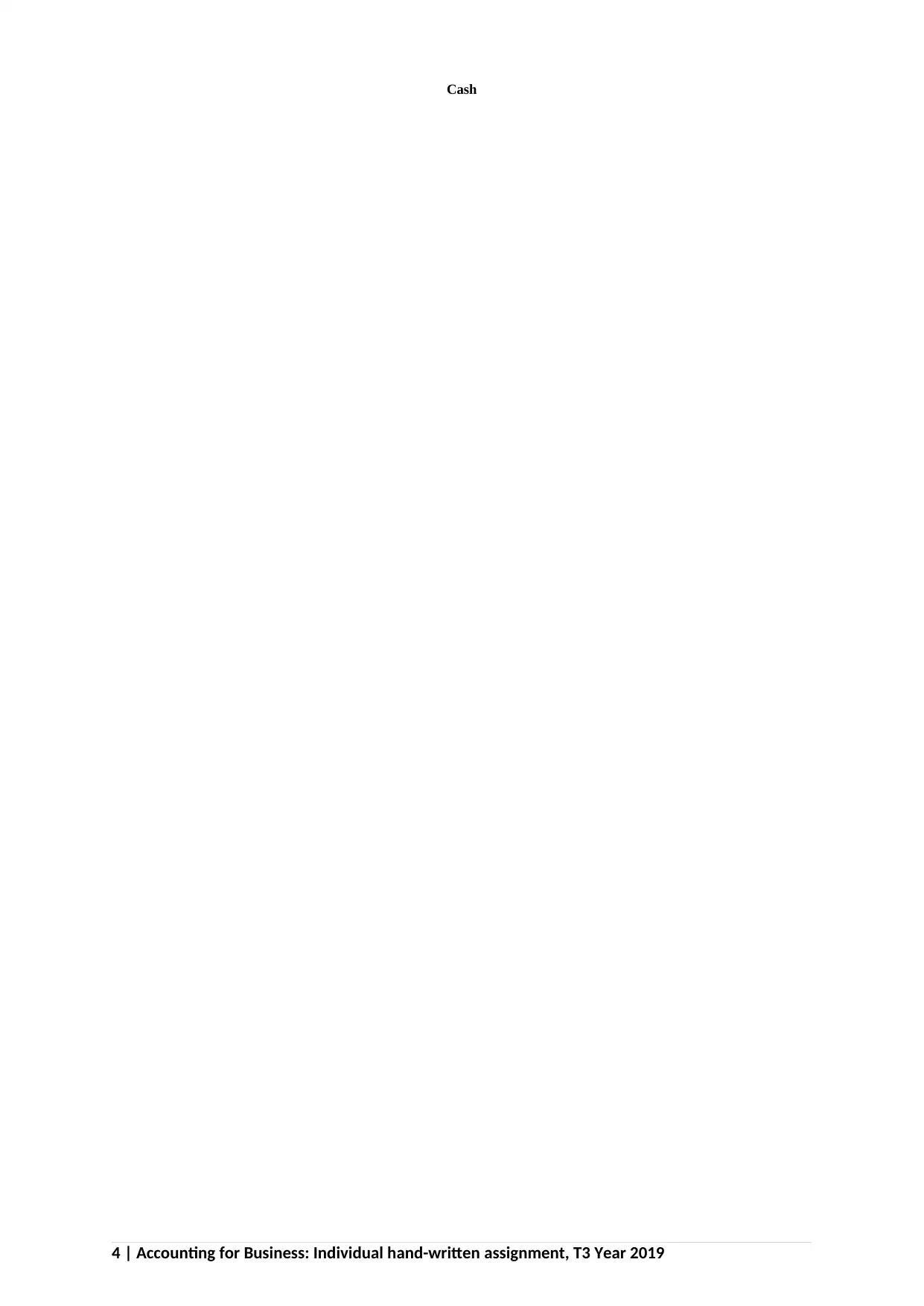
Cash
4 | Accounting for Business: Individual hand-written assignment, T3 Year 2019
4 | Accounting for Business: Individual hand-written assignment, T3 Year 2019
Paraphrase This Document
Need a fresh take? Get an instant paraphrase of this document with our AI Paraphraser
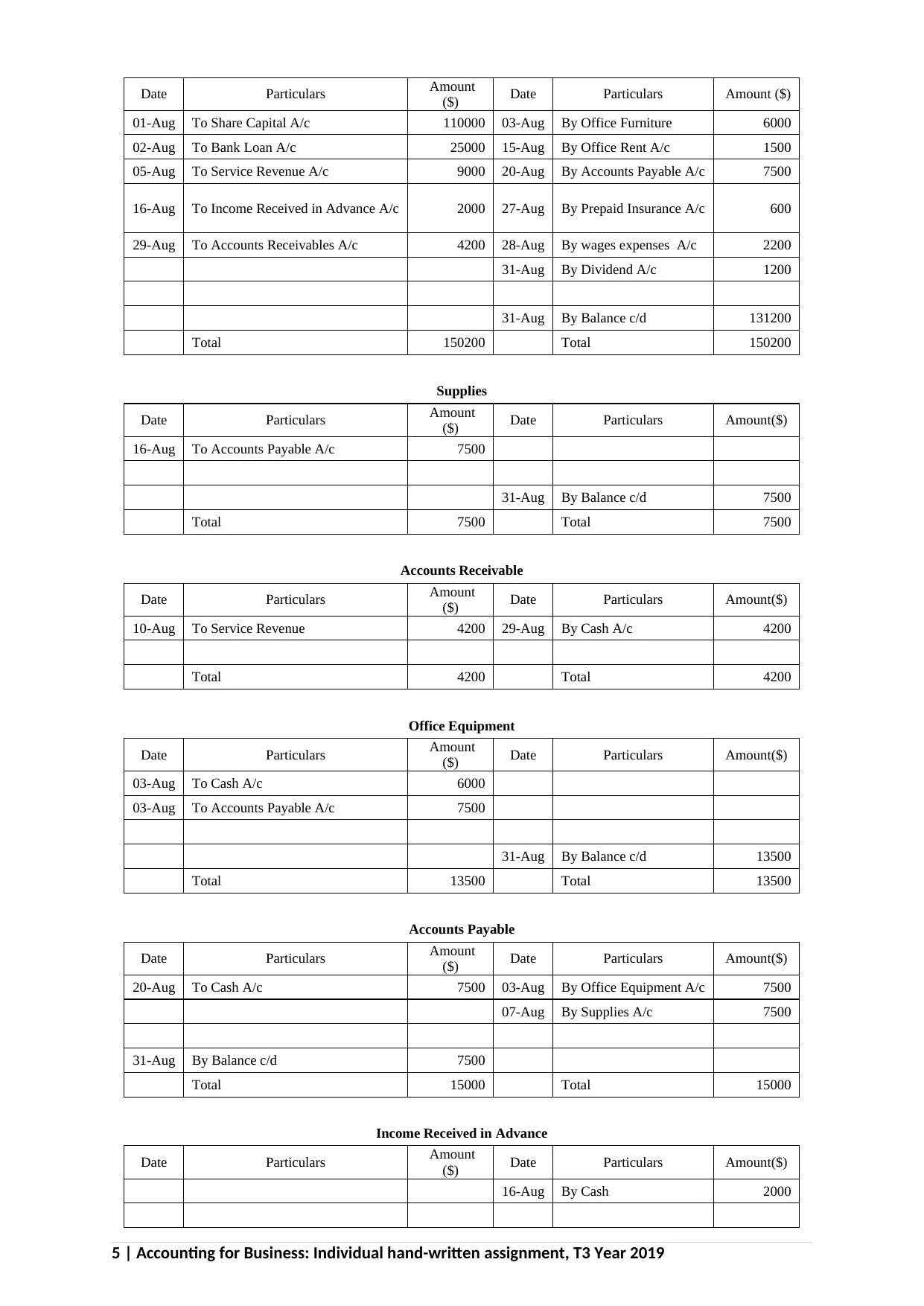
Date Particulars Amount
($) Date Particulars Amount ($)
01-Aug To Share Capital A/c 110000 03-Aug By Office Furniture 6000
02-Aug To Bank Loan A/c 25000 15-Aug By Office Rent A/c 1500
05-Aug To Service Revenue A/c 9000 20-Aug By Accounts Payable A/c 7500
16-Aug To Income Received in Advance A/c 2000 27-Aug By Prepaid Insurance A/c 600
29-Aug To Accounts Receivables A/c 4200 28-Aug By wages expenses A/c 2200
31-Aug By Dividend A/c 1200
31-Aug By Balance c/d 131200
Total 150200 Total 150200
Supplies
Date Particulars Amount
($) Date Particulars Amount($)
16-Aug To Accounts Payable A/c 7500
31-Aug By Balance c/d 7500
Total 7500 Total 7500
Accounts Receivable
Date Particulars Amount
($) Date Particulars Amount($)
10-Aug To Service Revenue 4200 29-Aug By Cash A/c 4200
Total 4200 Total 4200
Office Equipment
Date Particulars Amount
($) Date Particulars Amount($)
03-Aug To Cash A/c 6000
03-Aug To Accounts Payable A/c 7500
31-Aug By Balance c/d 13500
Total 13500 Total 13500
Accounts Payable
Date Particulars Amount
($) Date Particulars Amount($)
20-Aug To Cash A/c 7500 03-Aug By Office Equipment A/c 7500
07-Aug By Supplies A/c 7500
31-Aug By Balance c/d 7500
Total 15000 Total 15000
Income Received in Advance
Date Particulars Amount
($) Date Particulars Amount($)
16-Aug By Cash 2000
5 | Accounting for Business: Individual hand-written assignment, T3 Year 2019
($) Date Particulars Amount ($)
01-Aug To Share Capital A/c 110000 03-Aug By Office Furniture 6000
02-Aug To Bank Loan A/c 25000 15-Aug By Office Rent A/c 1500
05-Aug To Service Revenue A/c 9000 20-Aug By Accounts Payable A/c 7500
16-Aug To Income Received in Advance A/c 2000 27-Aug By Prepaid Insurance A/c 600
29-Aug To Accounts Receivables A/c 4200 28-Aug By wages expenses A/c 2200
31-Aug By Dividend A/c 1200
31-Aug By Balance c/d 131200
Total 150200 Total 150200
Supplies
Date Particulars Amount
($) Date Particulars Amount($)
16-Aug To Accounts Payable A/c 7500
31-Aug By Balance c/d 7500
Total 7500 Total 7500
Accounts Receivable
Date Particulars Amount
($) Date Particulars Amount($)
10-Aug To Service Revenue 4200 29-Aug By Cash A/c 4200
Total 4200 Total 4200
Office Equipment
Date Particulars Amount
($) Date Particulars Amount($)
03-Aug To Cash A/c 6000
03-Aug To Accounts Payable A/c 7500
31-Aug By Balance c/d 13500
Total 13500 Total 13500
Accounts Payable
Date Particulars Amount
($) Date Particulars Amount($)
20-Aug To Cash A/c 7500 03-Aug By Office Equipment A/c 7500
07-Aug By Supplies A/c 7500
31-Aug By Balance c/d 7500
Total 15000 Total 15000
Income Received in Advance
Date Particulars Amount
($) Date Particulars Amount($)
16-Aug By Cash 2000
5 | Accounting for Business: Individual hand-written assignment, T3 Year 2019
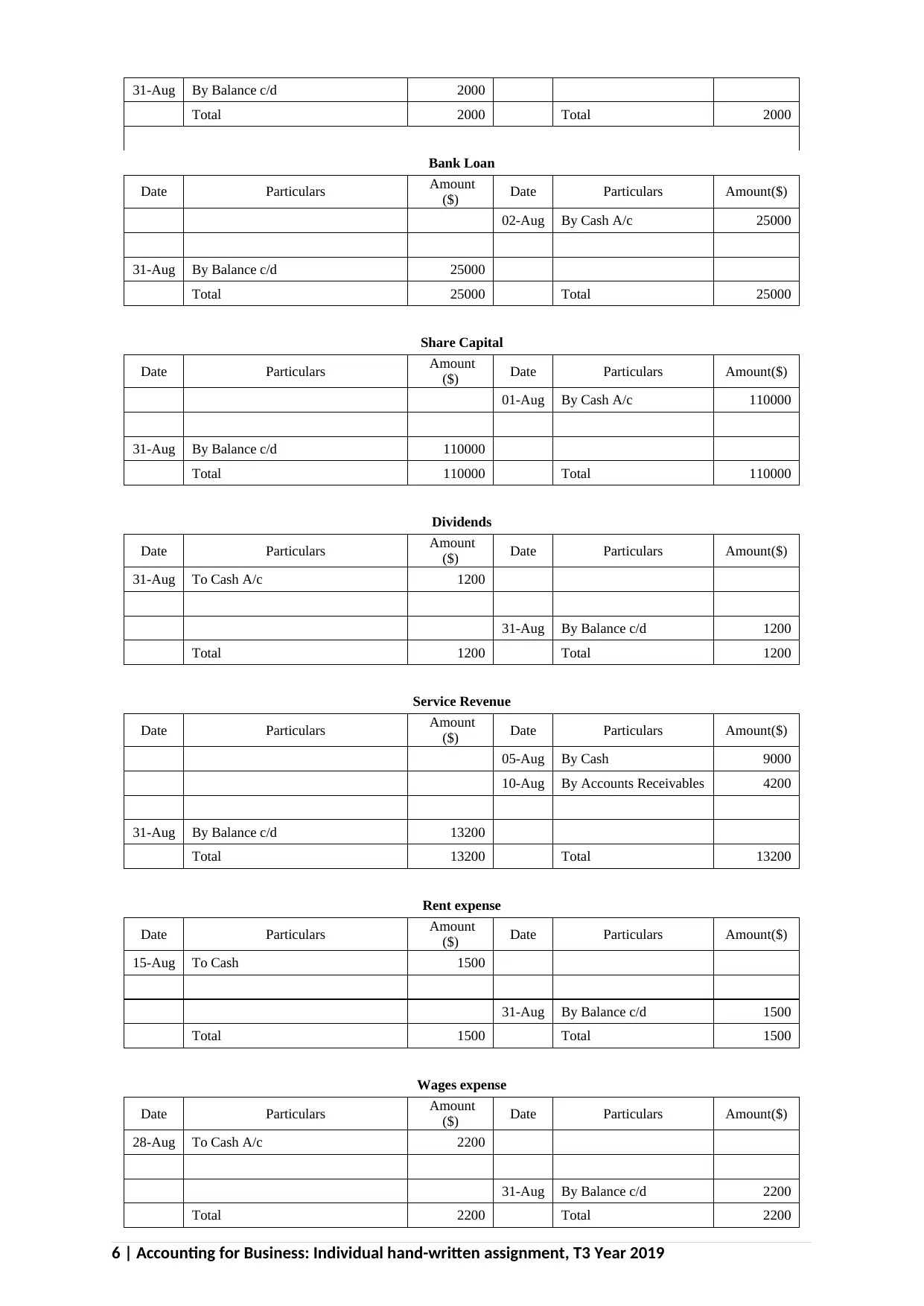
31-Aug By Balance c/d 2000
Total 2000 Total 2000
Bank Loan
Date Particulars Amount
($) Date Particulars Amount($)
02-Aug By Cash A/c 25000
31-Aug By Balance c/d 25000
Total 25000 Total 25000
Share Capital
Date Particulars Amount
($) Date Particulars Amount($)
01-Aug By Cash A/c 110000
31-Aug By Balance c/d 110000
Total 110000 Total 110000
Dividends
Date Particulars Amount
($) Date Particulars Amount($)
31-Aug To Cash A/c 1200
31-Aug By Balance c/d 1200
Total 1200 Total 1200
Service Revenue
Date Particulars Amount
($) Date Particulars Amount($)
05-Aug By Cash 9000
10-Aug By Accounts Receivables 4200
31-Aug By Balance c/d 13200
Total 13200 Total 13200
Rent expense
Date Particulars Amount
($) Date Particulars Amount($)
15-Aug To Cash 1500
31-Aug By Balance c/d 1500
Total 1500 Total 1500
Wages expense
Date Particulars Amount
($) Date Particulars Amount($)
28-Aug To Cash A/c 2200
31-Aug By Balance c/d 2200
Total 2200 Total 2200
6 | Accounting for Business: Individual hand-written assignment, T3 Year 2019
Total 2000 Total 2000
Bank Loan
Date Particulars Amount
($) Date Particulars Amount($)
02-Aug By Cash A/c 25000
31-Aug By Balance c/d 25000
Total 25000 Total 25000
Share Capital
Date Particulars Amount
($) Date Particulars Amount($)
01-Aug By Cash A/c 110000
31-Aug By Balance c/d 110000
Total 110000 Total 110000
Dividends
Date Particulars Amount
($) Date Particulars Amount($)
31-Aug To Cash A/c 1200
31-Aug By Balance c/d 1200
Total 1200 Total 1200
Service Revenue
Date Particulars Amount
($) Date Particulars Amount($)
05-Aug By Cash 9000
10-Aug By Accounts Receivables 4200
31-Aug By Balance c/d 13200
Total 13200 Total 13200
Rent expense
Date Particulars Amount
($) Date Particulars Amount($)
15-Aug To Cash 1500
31-Aug By Balance c/d 1500
Total 1500 Total 1500
Wages expense
Date Particulars Amount
($) Date Particulars Amount($)
28-Aug To Cash A/c 2200
31-Aug By Balance c/d 2200
Total 2200 Total 2200
6 | Accounting for Business: Individual hand-written assignment, T3 Year 2019
⊘ This is a preview!⊘
Do you want full access?
Subscribe today to unlock all pages.

Trusted by 1+ million students worldwide
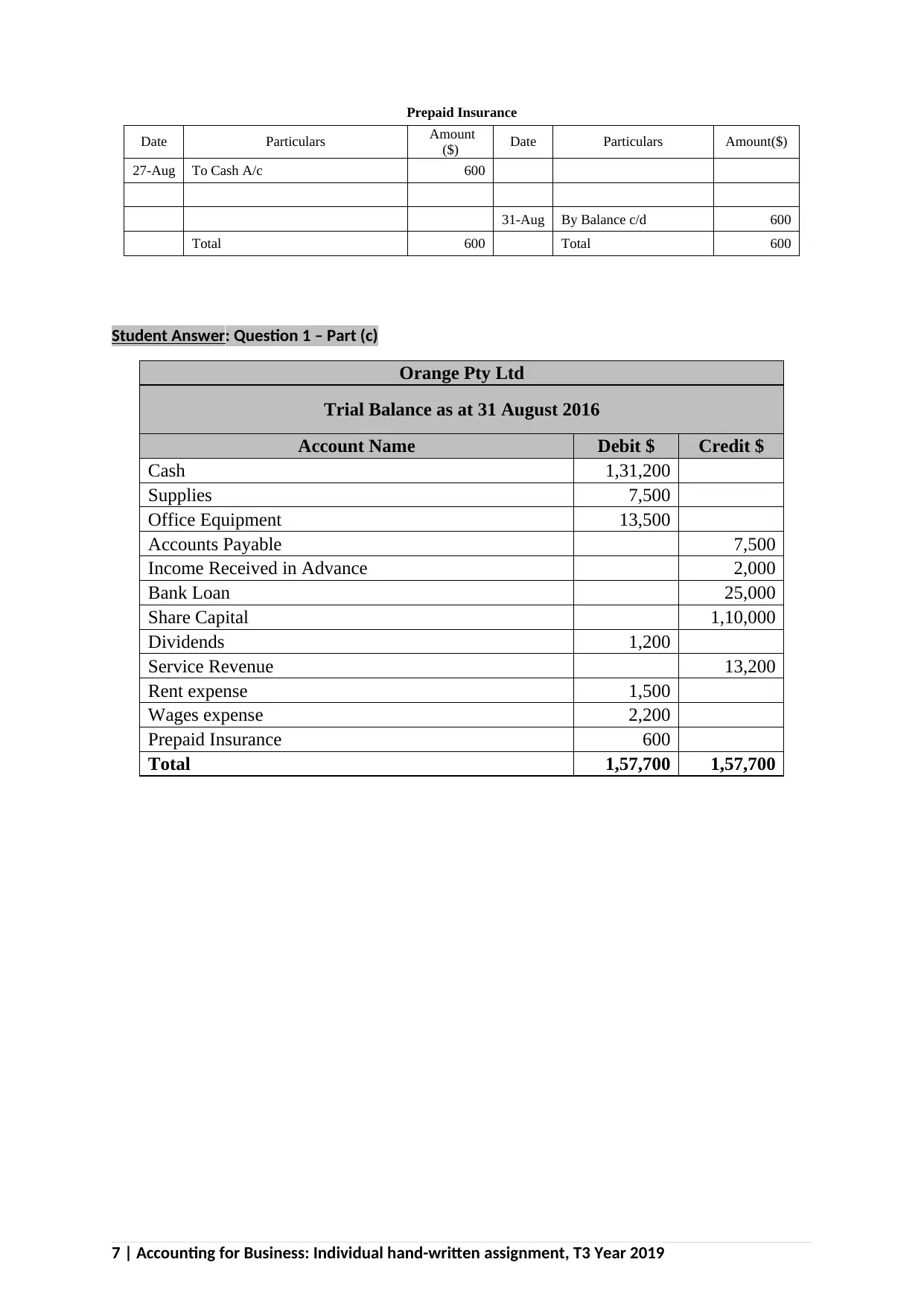
Prepaid Insurance
Date Particulars Amount
($) Date Particulars Amount($)
27-Aug To Cash A/c 600
31-Aug By Balance c/d 600
Total 600 Total 600
Student Answer: Question 1 – Part (c)
Orange Pty Ltd
Trial Balance as at 31 August 2016
Account Name Debit $ Credit $
Cash 1,31,200
Supplies 7,500
Office Equipment 13,500
Accounts Payable 7,500
Income Received in Advance 2,000
Bank Loan 25,000
Share Capital 1,10,000
Dividends 1,200
Service Revenue 13,200
Rent expense 1,500
Wages expense 2,200
Prepaid Insurance 600
Total 1,57,700 1,57,700
7 | Accounting for Business: Individual hand-written assignment, T3 Year 2019
Date Particulars Amount
($) Date Particulars Amount($)
27-Aug To Cash A/c 600
31-Aug By Balance c/d 600
Total 600 Total 600
Student Answer: Question 1 – Part (c)
Orange Pty Ltd
Trial Balance as at 31 August 2016
Account Name Debit $ Credit $
Cash 1,31,200
Supplies 7,500
Office Equipment 13,500
Accounts Payable 7,500
Income Received in Advance 2,000
Bank Loan 25,000
Share Capital 1,10,000
Dividends 1,200
Service Revenue 13,200
Rent expense 1,500
Wages expense 2,200
Prepaid Insurance 600
Total 1,57,700 1,57,700
7 | Accounting for Business: Individual hand-written assignment, T3 Year 2019
Paraphrase This Document
Need a fresh take? Get an instant paraphrase of this document with our AI Paraphraser
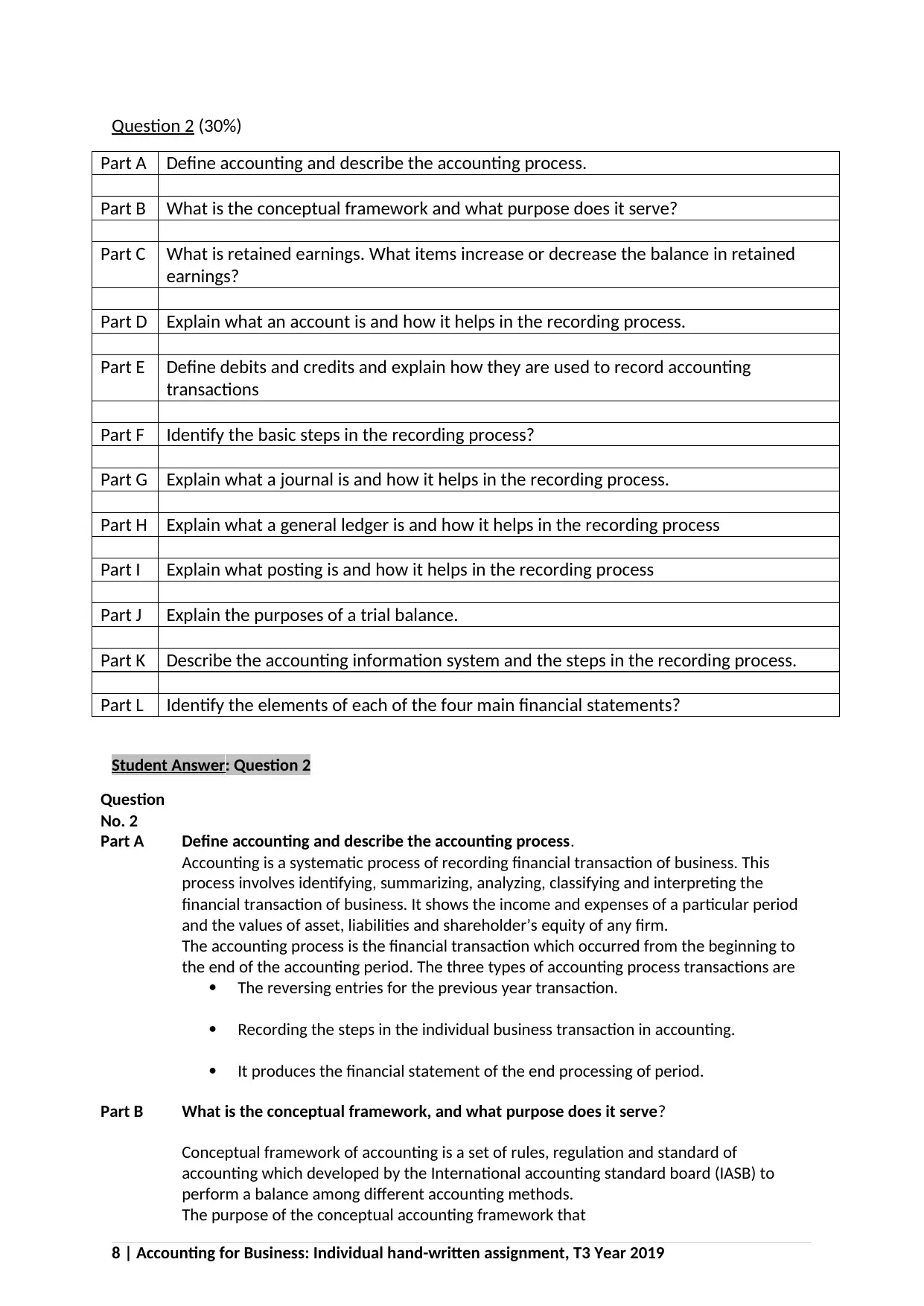
Question 2 (30%)
Part A Define accounting and describe the accounting process.
Part B What is the conceptual framework and what purpose does it serve?
Part C What is retained earnings. What items increase or decrease the balance in retained
earnings?
Part D Explain what an account is and how it helps in the recording process.
Part E Define debits and credits and explain how they are used to record accounting
transactions
Part F Identify the basic steps in the recording process?
Part G Explain what a journal is and how it helps in the recording process.
Part H Explain what a general ledger is and how it helps in the recording process
Part I Explain what posting is and how it helps in the recording process
Part J Explain the purposes of a trial balance.
Part K Describe the accounting information system and the steps in the recording process.
Part L Identify the elements of each of the four main financial statements?
Student Answer: Question 2
Question
No. 2
Part A Define accounting and describe the accounting process.
Accounting is a systematic process of recording financial transaction of business. This
process involves identifying, summarizing, analyzing, classifying and interpreting the
financial transaction of business. It shows the income and expenses of a particular period
and the values of asset, liabilities and shareholder’s equity of any firm.
The accounting process is the financial transaction which occurred from the beginning to
the end of the accounting period. The three types of accounting process transactions are
The reversing entries for the previous year transaction.
Recording the steps in the individual business transaction in accounting.
It produces the financial statement of the end processing of period.
Part B What is the conceptual framework, and what purpose does it serve?
Conceptual framework of accounting is a set of rules, regulation and standard of
accounting which developed by the International accounting standard board (IASB) to
perform a balance among different accounting methods.
The purpose of the conceptual accounting framework that
8 | Accounting for Business: Individual hand-written assignment, T3 Year 2019
Part A Define accounting and describe the accounting process.
Part B What is the conceptual framework and what purpose does it serve?
Part C What is retained earnings. What items increase or decrease the balance in retained
earnings?
Part D Explain what an account is and how it helps in the recording process.
Part E Define debits and credits and explain how they are used to record accounting
transactions
Part F Identify the basic steps in the recording process?
Part G Explain what a journal is and how it helps in the recording process.
Part H Explain what a general ledger is and how it helps in the recording process
Part I Explain what posting is and how it helps in the recording process
Part J Explain the purposes of a trial balance.
Part K Describe the accounting information system and the steps in the recording process.
Part L Identify the elements of each of the four main financial statements?
Student Answer: Question 2
Question
No. 2
Part A Define accounting and describe the accounting process.
Accounting is a systematic process of recording financial transaction of business. This
process involves identifying, summarizing, analyzing, classifying and interpreting the
financial transaction of business. It shows the income and expenses of a particular period
and the values of asset, liabilities and shareholder’s equity of any firm.
The accounting process is the financial transaction which occurred from the beginning to
the end of the accounting period. The three types of accounting process transactions are
The reversing entries for the previous year transaction.
Recording the steps in the individual business transaction in accounting.
It produces the financial statement of the end processing of period.
Part B What is the conceptual framework, and what purpose does it serve?
Conceptual framework of accounting is a set of rules, regulation and standard of
accounting which developed by the International accounting standard board (IASB) to
perform a balance among different accounting methods.
The purpose of the conceptual accounting framework that
8 | Accounting for Business: Individual hand-written assignment, T3 Year 2019
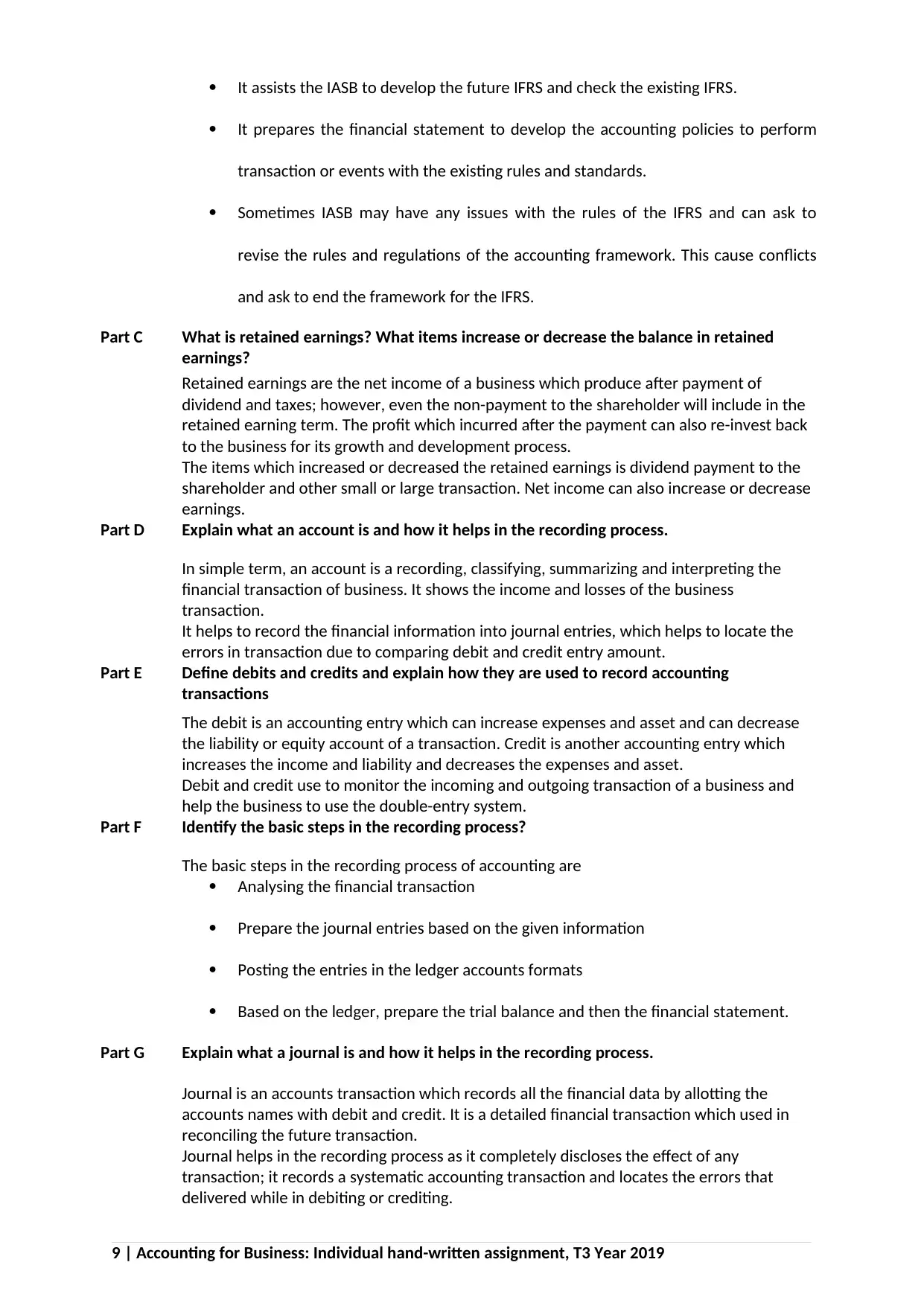
It assists the IASB to develop the future IFRS and check the existing IFRS.
It prepares the financial statement to develop the accounting policies to perform
transaction or events with the existing rules and standards.
Sometimes IASB may have any issues with the rules of the IFRS and can ask to
revise the rules and regulations of the accounting framework. This cause conflicts
and ask to end the framework for the IFRS.
Part C What is retained earnings? What items increase or decrease the balance in retained
earnings?
Retained earnings are the net income of a business which produce after payment of
dividend and taxes; however, even the non-payment to the shareholder will include in the
retained earning term. The profit which incurred after the payment can also re-invest back
to the business for its growth and development process.
The items which increased or decreased the retained earnings is dividend payment to the
shareholder and other small or large transaction. Net income can also increase or decrease
earnings.
Part D Explain what an account is and how it helps in the recording process.
In simple term, an account is a recording, classifying, summarizing and interpreting the
financial transaction of business. It shows the income and losses of the business
transaction.
It helps to record the financial information into journal entries, which helps to locate the
errors in transaction due to comparing debit and credit entry amount.
Part E Define debits and credits and explain how they are used to record accounting
transactions
The debit is an accounting entry which can increase expenses and asset and can decrease
the liability or equity account of a transaction. Credit is another accounting entry which
increases the income and liability and decreases the expenses and asset.
Debit and credit use to monitor the incoming and outgoing transaction of a business and
help the business to use the double-entry system.
Part F Identify the basic steps in the recording process?
The basic steps in the recording process of accounting are
Analysing the financial transaction
Prepare the journal entries based on the given information
Posting the entries in the ledger accounts formats
Based on the ledger, prepare the trial balance and then the financial statement.
Part G Explain what a journal is and how it helps in the recording process.
Journal is an accounts transaction which records all the financial data by allotting the
accounts names with debit and credit. It is a detailed financial transaction which used in
reconciling the future transaction.
Journal helps in the recording process as it completely discloses the effect of any
transaction; it records a systematic accounting transaction and locates the errors that
delivered while in debiting or crediting.
9 | Accounting for Business: Individual hand-written assignment, T3 Year 2019
It prepares the financial statement to develop the accounting policies to perform
transaction or events with the existing rules and standards.
Sometimes IASB may have any issues with the rules of the IFRS and can ask to
revise the rules and regulations of the accounting framework. This cause conflicts
and ask to end the framework for the IFRS.
Part C What is retained earnings? What items increase or decrease the balance in retained
earnings?
Retained earnings are the net income of a business which produce after payment of
dividend and taxes; however, even the non-payment to the shareholder will include in the
retained earning term. The profit which incurred after the payment can also re-invest back
to the business for its growth and development process.
The items which increased or decreased the retained earnings is dividend payment to the
shareholder and other small or large transaction. Net income can also increase or decrease
earnings.
Part D Explain what an account is and how it helps in the recording process.
In simple term, an account is a recording, classifying, summarizing and interpreting the
financial transaction of business. It shows the income and losses of the business
transaction.
It helps to record the financial information into journal entries, which helps to locate the
errors in transaction due to comparing debit and credit entry amount.
Part E Define debits and credits and explain how they are used to record accounting
transactions
The debit is an accounting entry which can increase expenses and asset and can decrease
the liability or equity account of a transaction. Credit is another accounting entry which
increases the income and liability and decreases the expenses and asset.
Debit and credit use to monitor the incoming and outgoing transaction of a business and
help the business to use the double-entry system.
Part F Identify the basic steps in the recording process?
The basic steps in the recording process of accounting are
Analysing the financial transaction
Prepare the journal entries based on the given information
Posting the entries in the ledger accounts formats
Based on the ledger, prepare the trial balance and then the financial statement.
Part G Explain what a journal is and how it helps in the recording process.
Journal is an accounts transaction which records all the financial data by allotting the
accounts names with debit and credit. It is a detailed financial transaction which used in
reconciling the future transaction.
Journal helps in the recording process as it completely discloses the effect of any
transaction; it records a systematic accounting transaction and locates the errors that
delivered while in debiting or crediting.
9 | Accounting for Business: Individual hand-written assignment, T3 Year 2019
⊘ This is a preview!⊘
Do you want full access?
Subscribe today to unlock all pages.

Trusted by 1+ million students worldwide
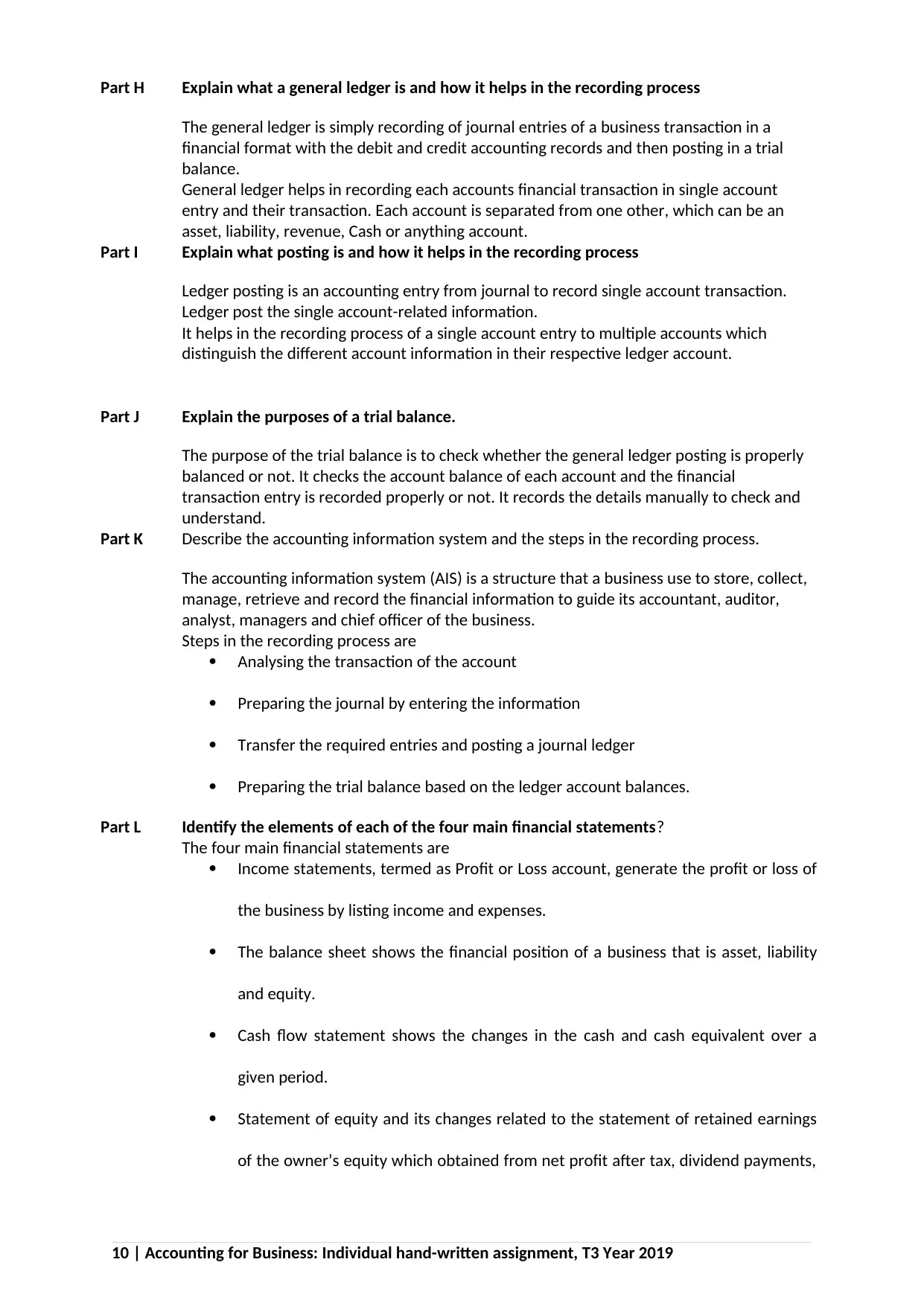
Part H Explain what a general ledger is and how it helps in the recording process
The general ledger is simply recording of journal entries of a business transaction in a
financial format with the debit and credit accounting records and then posting in a trial
balance.
General ledger helps in recording each accounts financial transaction in single account
entry and their transaction. Each account is separated from one other, which can be an
asset, liability, revenue, Cash or anything account.
Part I Explain what posting is and how it helps in the recording process
Ledger posting is an accounting entry from journal to record single account transaction.
Ledger post the single account-related information.
It helps in the recording process of a single account entry to multiple accounts which
distinguish the different account information in their respective ledger account.
Part J Explain the purposes of a trial balance.
The purpose of the trial balance is to check whether the general ledger posting is properly
balanced or not. It checks the account balance of each account and the financial
transaction entry is recorded properly or not. It records the details manually to check and
understand.
Part K Describe the accounting information system and the steps in the recording process.
The accounting information system (AIS) is a structure that a business use to store, collect,
manage, retrieve and record the financial information to guide its accountant, auditor,
analyst, managers and chief officer of the business.
Steps in the recording process are
Analysing the transaction of the account
Preparing the journal by entering the information
Transfer the required entries and posting a journal ledger
Preparing the trial balance based on the ledger account balances.
Part L Identify the elements of each of the four main financial statements?
The four main financial statements are
Income statements, termed as Profit or Loss account, generate the profit or loss of
the business by listing income and expenses.
The balance sheet shows the financial position of a business that is asset, liability
and equity.
Cash flow statement shows the changes in the cash and cash equivalent over a
given period.
Statement of equity and its changes related to the statement of retained earnings
of the owner’s equity which obtained from net profit after tax, dividend payments,
10 | Accounting for Business: Individual hand-written assignment, T3 Year 2019
The general ledger is simply recording of journal entries of a business transaction in a
financial format with the debit and credit accounting records and then posting in a trial
balance.
General ledger helps in recording each accounts financial transaction in single account
entry and their transaction. Each account is separated from one other, which can be an
asset, liability, revenue, Cash or anything account.
Part I Explain what posting is and how it helps in the recording process
Ledger posting is an accounting entry from journal to record single account transaction.
Ledger post the single account-related information.
It helps in the recording process of a single account entry to multiple accounts which
distinguish the different account information in their respective ledger account.
Part J Explain the purposes of a trial balance.
The purpose of the trial balance is to check whether the general ledger posting is properly
balanced or not. It checks the account balance of each account and the financial
transaction entry is recorded properly or not. It records the details manually to check and
understand.
Part K Describe the accounting information system and the steps in the recording process.
The accounting information system (AIS) is a structure that a business use to store, collect,
manage, retrieve and record the financial information to guide its accountant, auditor,
analyst, managers and chief officer of the business.
Steps in the recording process are
Analysing the transaction of the account
Preparing the journal by entering the information
Transfer the required entries and posting a journal ledger
Preparing the trial balance based on the ledger account balances.
Part L Identify the elements of each of the four main financial statements?
The four main financial statements are
Income statements, termed as Profit or Loss account, generate the profit or loss of
the business by listing income and expenses.
The balance sheet shows the financial position of a business that is asset, liability
and equity.
Cash flow statement shows the changes in the cash and cash equivalent over a
given period.
Statement of equity and its changes related to the statement of retained earnings
of the owner’s equity which obtained from net profit after tax, dividend payments,
10 | Accounting for Business: Individual hand-written assignment, T3 Year 2019
Paraphrase This Document
Need a fresh take? Get an instant paraphrase of this document with our AI Paraphraser
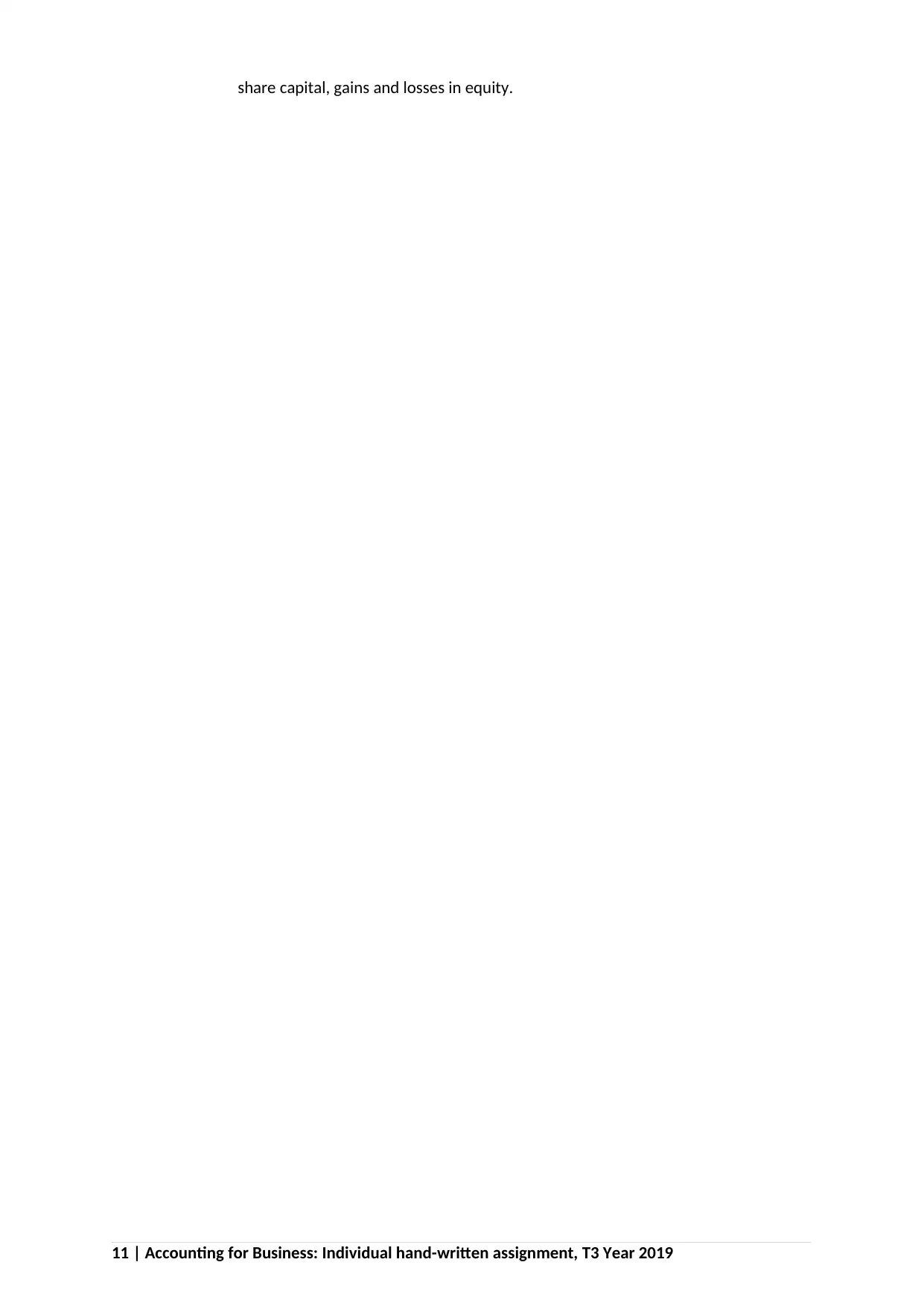
share capital, gains and losses in equity.
11 | Accounting for Business: Individual hand-written assignment, T3 Year 2019
11 | Accounting for Business: Individual hand-written assignment, T3 Year 2019
1 out of 11
Related Documents
Your All-in-One AI-Powered Toolkit for Academic Success.
+13062052269
info@desklib.com
Available 24*7 on WhatsApp / Email
![[object Object]](/_next/static/media/star-bottom.7253800d.svg)
Unlock your academic potential
Copyright © 2020–2025 A2Z Services. All Rights Reserved. Developed and managed by ZUCOL.



